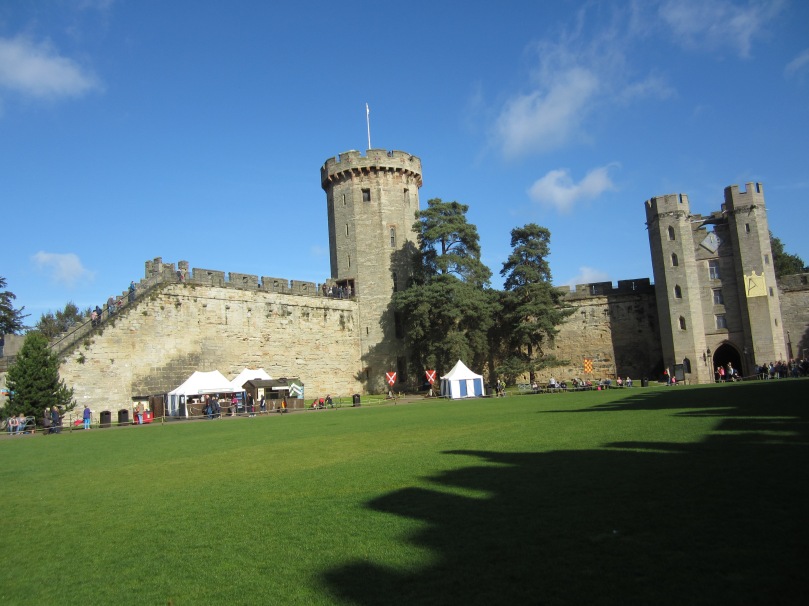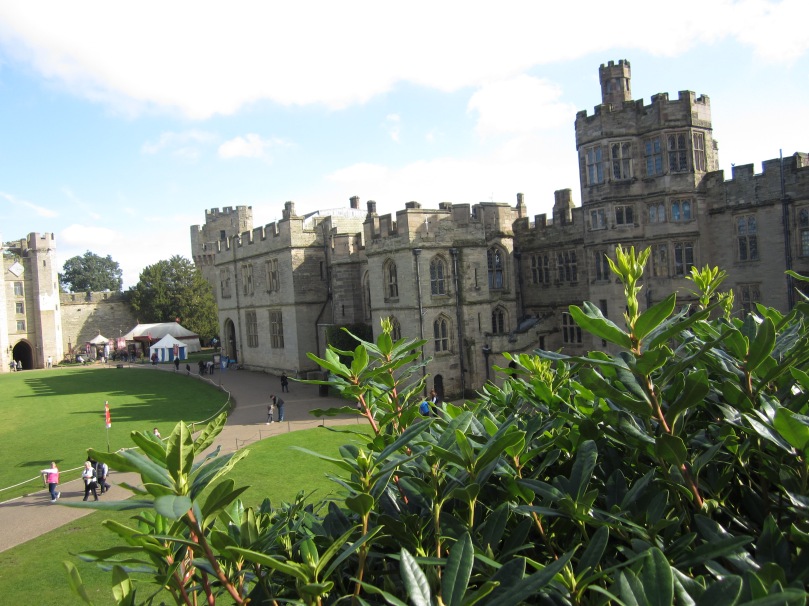
The Freelance History Writer is pleased to welcome N.B. Dixon to the blog. She is an author of Historical Fiction, currently working on a series based around the legend of Robin Hood. Book 1: Heir of Locksley will be released December 2016. You can visit her on her website: http://www.nbdixonauthor.com/
These days, Warwick Castle is a popular tourist attraction. Visitors can explore the dungeons and climb the ramparts. There are jousting and archery events, as well as the ritual firing of the trebuchet and much more to be enjoyed. However, a single visit is not nearly enough to learn the history of this magnificent English castle. Warwick Castle boasts more than its fair share of dark deeds and tragedies.
It was begun in 1068, one of the many castles William the Conqueror ordered built in an effort to fortify his newly won kingdom. The castle began life as a wooden motte and bailey construction, but was rebuilt in stone in 1260. Several earls added to the original building, including the erection of Caesar’s tower and the dungeons in 1350, and the completion of Guy’s tower in 1395. William the Conqueror, later known as William I, appointed Henry de Beaumont, son of a prominent Norman family as constable of the castle and in 1088, he became the first Earl of Warwick.

In 1153, the wife of the second Earl of Warwick, Roger de Beaumont, was tricked into handing over control of the castle to the forces of Henry II. Roger is said to have died on hearing the news. Henry later restored the castle to the Earls of Warwick in gratitude for their loyalty to his mother, Empress Matilda, during her struggle for the English throne (1135 to 1154). During the rebellion of 1173 to 1174, the Earl of Warwick remained loyal to Henry II.
On the death of Thomas de Beaumont, sixth Earl of Warwick, ownership passed to his sister, Lady Margery. Her husband died soon after, but the earldom was awarded to her new husband, John du Plessis, in December 1242. In 1264, the castle was attacked by Simon de Monforte, sixth Earl of Leicester. William Maudit, the eighth Earl of Warwick, was a staunch supporter of King Henry III, and he and his wife were taken to Kenilworth Castle and held for ransom. After Maudit’s death in 1267, the title passed to his nephew, William de Beauchamp.

Warwick Castle was the setting for some high profile criminal trials, the most notorious of which was that of Piers Gaveston in 1312. Gaveston was the close friend, and it was whispered, the lover of Edward II. Gaveston seems to have possessed a talent for treading on important toes. He was exiled during the reign of Edward II’s father, Edward I, but returned to England after Edward II’s accession to the throne. Many nobles felt Gaveston’s influence over the King was too great. Among them was Thomas, Earl of Lancaster, who would later lead a rebellion against King Edward. King Edward reluctantly agreed to Gaveston’s second exile, but the nobles were eventually persuaded to agree to his return. Gaveston’s behaviour was so offensive that he was exiled a third time. In spite of the very real danger to his life, Gaveston returned yet again and was captured by Lancaster and Guy de Beauchamp, tenth Earl of Warwick. Gaveston was imprisoned at Warwick Castle. After a brief trial, he was taken out and executed. Richard Beauchamp, Earl of Warwick was the supervisor of the trial of Joan of Arc in 1431. She was accused of heresy and sentenced to burn at the stake. Her trial and death took place in Rouen, France.
The earls of Warwick were among some of the most powerful and wealthy men in England. Perhaps the most famous of these was Richard Neville, also known as the Kingmaker. He was an instrumental figure during the Wars of the Roses, the battle for the English throne between the two royal houses of Lancaster and York. The Kingmaker gained his title for helping to put no fewer than two monarchs on the throne. He began by fighting for the Yorkist faction. He was responsible for helping to depose Henry VI and replace him with Edward, son of Richard, Duke of York. Edward was crowned Edward IV, but relations between him and Neville rapidly deteriorated. The problem began when Neville was sent to France to negotiate a marriage between Edward IV and a French princess, only to return and find that Edward had married in secret. Neville must have felt he had been made to look a fool, and things continued to go downhill between them. The culmination was the imprisonment of Edward IV by Neville in Warwick Castle, and though he was later released, there was no repairing the damage. Neville changed sides. He helped restore Henry VI to his throne, but the restoration was brief. Within months, Edward IV would be King once more, and the Kingmaker would be dead, killed at the Battle of Barnet in 1471.

Edward awarded Warwick Castle to his brother George Plantagenet, Duke of Clarence. He was executed for treason in 1478. His mother pleaded for him to be spared the traditional death reserved for traitors, so he was supposedly drowned in a barrel of wine. Another Earl of Warwick to meet an unfortunate end was Fulke Greville, who was murdered by his own manservant in 1628. He was stabbed twice after his servant discovered he had been left a less than satisfactory amount of money in Greville’s will.
The castle was besieged in 1642 by Royalist forces. The castle inhabitants refused to surrender, and though cannons were fired, they produced little effect. The Royalists were forced to retreat. After the battle of Edghill in 1642, several Royalist prisoners were held in the castle. In 1871, a fire ravaged the hall and royal apartments, but was eventually brought under control. Warwick Castle has withstood fire and siege, it has weathered scandals and witnessed trials and murders. Unlike others, Warwick Castle really has withstood the test of time.
Further reading: “Warwick Castle and its Earls: Vol. 1” by Frances Maynard Evelyn Greville Warwick, “Warwick Castle” by Paul Barker, “Warwick Castle: its history and treasures in pictures” by J A Brooks
As usual, a very interesting article. I have enjoyed as I have read the previous comments, the historical knowledge of of this castle engendered by your other readers.
LikeLiked by 1 person
Reblogged this on England's History.
LikeLike
Henry Beaumont’s brother was Robert Beaumont, Count of Meulan and first Earl of Leicester.
Meulan was an independent County (in the Vexin) with its capital Meulan-en-Yvelines on the Seine river, downstream of Paris. The Beaumonts weren’t Normans but maintained a strategic alliance with its Dukes in order to maintain effective independence from the kings of France.
The sixth Earl of Warwick, Thomas Beaumont, had some Breton descent, as his coat-of-arms bore a “chevron ermine” (see https://en.m.wikipedia.org/wiki/Thomas_de_Beaumont,_6th_Earl_of_Warwick).
St Nicaise was the main church in 11th century Meulan. It is on an island in the Seine and was the parish centre for the Vexin, including nearby Aincourt, where Walter d’Aincourt came from.
Walter was a landholder in Derby during Edward the Confessor’s reign, and a lesser tenant-in-chief under William the Conqueror. Walter’s wife Matilda was of royal descent. Trevor Foulds suggested in passing that she be identified with William’s daughter Matilda, though Richard Sharp is convinced she was a daughter of Alan Rufus and Gunhild of Wessex.
In support of Foulds’s notion, Walter and Matilda’s eldest son was named William. He was raised in the royal court, died young, but successive generations of the family recurrently gave the names William and Matilda to their eldest offspring. By contrast, “Alan”, “Gunhild”, “Harold”, “Godwin” and other names you might expect of their descendants never occurred in the d’Aincourt family.
Moreover, King William’s daughter Matilda is identified in a memoral record of her in the church of St Nicaise.
LikeLike
This Wikipedia article on Thomas de Beaumont is in error saying that his mother was Margaret D’Oilli. She was his grandmother. His mother was Philippe Basset daughter of Thomas Basset who had bought the marriage and wardship of Thomas for one of his daughters.
LikeLiked by 1 person
Beautiful chapel. Which denomination is it?
LikeLike
Hi Michael, My best guess is the chapel is Church of England. The castle was owned by the crown under the Tudors and by John Dudley, Earl of Warwick and 1st Duke of Northumberland, a notorious Protestant. He was the one that tried to put Jane Grey on the throne over Mary Tudor.
LikeLike
Loved this post! It referred to many of my family members, and clarified the story of the castle itself. I’ll never get to see the real thing, but this post is a good consolation prize.
LikeLike
I believe Joan was held in England for ransom. Eventually she was turned over to the French. Unfortunately I don’t have sources for this information.
LikeLike
She was held for ransom by the Burgundians. The English paid the ransom but Joan herself never went to England.
LikeLike